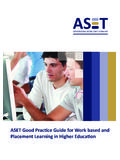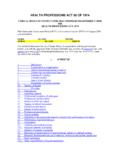Transcription of AS T
1 AS T. INTEGRATING WORK AND LEARNING. ASET Good Practice Guide for Health and Safety for Student Placements Revised and Updated 2016. Acknowledgements ASET has been involved in promoting good practice around placements since 1982, the terminology then was sandwich education, and limited to the year students would spend in the workplace as part of their university education, but now the broader term work based and placement learning (WBPL) is used to fully encompass the breadth of opportunities available to students, irrespective of their level or mode of study. ASET's goal remains the same: to advance the prevalence, effectiveness and quality of work based and placement learning in Higher Education. Part of this good practice is ensuring the Health and Safety of students, hence this Guide now in its third edition.
2 This Guide, which offers practical implementation support, may usefully be read in conjunction with the USHA/UCEA. publication Health and Safety Guidance for the Placement of Higher Education Students (2009), which is intended as strategic guidance. ASET acknowledges the contribution of members of the UCEA working party during the valuable collaborative developmental process leading to the publication of previous editions;. and the authors of the CVCP publication Health and Safety Guidance for the Placement of HE. Students (1997). In addition to this, documents developed by the USHA Yorkshire Regional Group Health and Safety Guidance for the Placement of HE Students (2007) and Les Wright at Sheffield Hallam University Health and Safety of Placement Students (2008) have also been important in furthering the debate.
3 The insurance section of this document is adapted from the University of Bristol guidance Insurance for Student Placements (2008) written by Ginny Hope and produced in 2010 with the additional assistance of Martin Hampar from the University of Manchester. The second edition of this Guide was produced in 2010 by an ASET working party consisting of: Carrie de Silva, LLB (Hons) MA (Principal Lecturer in Law and Taxation, Harper Adams University), Keith Fildes, MA PhD (Researcher Development Adviser, Sheffield Hallam University), and David Tattersall, BSc CEng MICE (Regional Director, Institution of Civil Engineers). This third edition has been revised and updated by Carrie de Silva in September 2016, with assistance from Sarah Flynn (University of Hertfordshire), Debbie Siva-Jothy (ASET) and Colin Turner (Ulster University).
4 ASET and Contributors, September 2016. Note The guidance herein is in accordance with good practice and with our interpretation of UK. law at the date of publication (September 2016). The law is however, complex and ever- changing. You must consider carefully the information presented and reach your own judgement as to its application to your own circumstances. ASET (1982) Limited is unable to give any guarantees or undertakings. The law of health and safety applies across all countries of the UK. Differences between England and Wales, Scotland and Northern Ireland are in criminal procedure and courts, along with any difference in civil consequences regarding negligence, the Scottish law of delict, etc. The relevant branches of the Health and Safety Executive are: England and Wales Scotland Northern Ireland Contents Definitions 4.
5 Note to Heads of Higher Education Providers (HEP) 5. Introduction 5. Scope 6. Origin of this Guide 7. Legal Liability 8. Risk and Hazard 9. Risk Management 9. Practical Guidance 12. Insurance 21. Appendices 28. Tool A Risk Profiling and Action Necessary 28. Tool B Risk Assessment Form 31. Tool C Content of Written Communication 34. References and Bibliography 36. Definitions The focus of this Guide is to provide some specific guidance for those supporting students on courses where work based and placement learning opportunities are a planned and integrated part of a student's programme of study at a Higher Education Provider (HEP), (this includes universities, colleges and private providers). It is intended to be useful to practitioners irrespective of the level or mode of study, the academic subject, whether work based or placement learning (WBPL).
6 This Guide has been written to support the development of good practice, but is neither prescriptive nor regulatory. We would recommend reading this Guide alongside the ASET Good Practice Guide for Work based and Placement Learning in Higher Education (2013) which provides extended terminology associated with placement learning, but in summary the following definitions are used throughout this Guide: Placement A period of work experience, paid or unpaid: which is undertaken as an integral part of the student's programme, and where the student is enrolled at the HEP during this period, and where there is a transfer of direct supervision of the student to a third party For self-employed placement students where there is no such transfer of direct supervision see page 6, Scope.
7 Employer A third party (usually an employer) who, during the placement, has responsibility for the direct supervision of the student. Note that any HEP (including the one at which the student is enrolled) providing the work experience on their premises as a placement, would be the employer. Placement practitioner Any individual authorised by the HEP to agree the placement of a student and, in some cases, responsible for visiting students on placement. Workplace supervisor A person designated by the employer to supervise the student during the placement. 4. Note to Heads of Higher Education Providers (HEP). Authoritative strategic guidance in these matters is contained in the UCEA Health and Safety Guidance for the Placement of Higher Education Students (2009), which assumes that HEPs will develop their own detailed procedures for implementation.
8 As the person ultimately responsible for the HEP and its personnel, Heads should ensure all relevant staff are aware of their responsibilities and are implementing appropriate procedures. Each HEP should have policy statements on the procurement and management of student placements, including the management of health and safety, and actions should be compatible with these policies, procedures and guidelines. This ASET document is comprehensive and contains practical operational guidance. Issuing it to appropriate staff and ensuring they follow it will help fulfil your legal obligations, provided the necessary support, including training if required, is given. This ASET document is written specifically for the use of placement practitioners.
9 There are clear advantages to employers and HEPs in using common guidance and similar methods. The use of different guidance, which may reduce the risk even further, is not precluded whether this be a modified version of these recommendations, or an existing procedure. Introduction The world of work can be risky. For some people it can result in health problems, injury or death. People entering work for the first time are more vulnerable than others and for many students a placement is their first experience of full-time work, or indeed work at all. Everyone involved in a placement has an ethical responsibility to do what they can to reduce the chances of harm to the student and the harm that a student may do to others.
10 HEP staff can influence these matters and this document provides practical guidance to help them. It should be noted that, arising from the Health and Safety at Work etc. Act 1974, there is also a legal responsibility for HEPs in the UK to do this. In addition to reducing the risk to students, following this guidance should enable HEPs to demonstrate they have done what can be considered as reasonably practicable to discharge their duty of care. Records relating to process and procedure are vital in the event of legal action. The Practical Guidance from page 12 onwards should not be used in isolation, but with an understanding of the responsibilities described elsewhere in this document. The UCEA. Health and Safety Guidance for the Placement of Higher Education Students (2009), which is underpinned by the same principles as this document, also provides useful information on the relevant strategic context.



